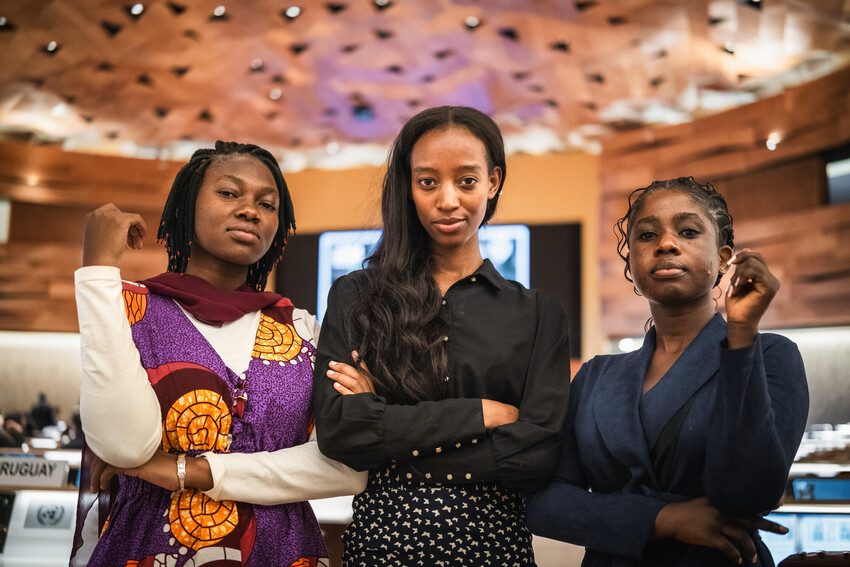Girls’ rights are under threat. Here’s why
12 December 2024Without urgent global action, millions of girls are at risk of growing up with fewer rights and freedoms than their grandmothers, write Charlotte Stemmer Head of Plan International’s United Nations Liaison Office in Geneva and Debora Cobar, Head of Plan International’s United Nations Liaison Office in New York.

Despite significant strides in international law and policy to include and empower girls, their rights are under increasing threat from a growing tide of movements opposing gender equality. Without urgent global action, millions of girls are at risk of growing up with fewer rights and freedoms than their grandmothers.
Fewer rights than their grandmothers. This is what may await girls growing today, unless concrete action is taken to safeguard decades of hard-won progress. Plan International reviewed over 3,600 international policy documents in the recent report ‘Strengthening Girls’ Rights as Human Rights’, noting significant efforts to increase the visibility of girls and their rights on the world’s stage. However, recent gains in health, education, and violence prevention are fragile due to rising opposition, particularly in areas like sexual and reproductive rights.
More visible, not yet seen enough
Since 2018, a growing number of global agreements have increasingly made explicit mentions to girls, whose specific rights are being discussed in greater depth in global fora. Girls have been more frequently involved at the United Nations and recognised as leaders of change. In July 2023, for the first time, a girl directly participated in the negotiations of a resolution on child marriage, ensuring that the final text would reflect the lived realities of individuals directly impacted. Particular progress has been made in the health and education sectors, with texts mentioning the equal enjoyment of rights by “every girl”. Other resolutions have also called on the “elimination of all forms of discrimination against women and girls”, pressing the need to address violence against girls as a field of its own.
Yet, these advances are uneven and fragile. In sensitive domains like economic and political rights, girls get pushed to the margins, leaving critical gaps to ensure their full protection as well as their ability to autonomously determine their futures. In addition, movements hostile to gender equality have further been politicising the progress made, leading to the adoption of more restrictive policies in key areas such sexual and reproductive health. Anti-rights actors are also manipulating language, undermining solidarity between girls’ rights defenders and pushing negotiators to use less inclusive wording. This slows down efforts to secure full rights and protections for all girls.
It is essential that international law recognises and includes girls in all their diversity.
Language matters. It plays an important role in breaking down harmful stereotypes and giving visibility to otherwise marginalised groups. What states say on the world stage guides their policies, thus shaping the concrete effects girls feel in their daily lives. It is thus essential to ensure that international law recognises and includes girls in all their diversity. Similarly, policies must be guided by intersectional approaches that reflect the diversity of girls’ identities and experiences. Without this, millions of young women will continue to face systemic barriers to equality and justice.
What must be done
International policies must do a better job of recognising girls as individuals with their own rights. This means, that global instruments should address girls’ specific needs and experiences, no matter their backgrounds and circumstances. Governments and organisations must seek to understand the full range of challenges that girls face, from discrimination to violence, and create policies that reflect their diverse and lived realities.
But policies and programs won’t succeed unless they include the voices of girls themselves, as they know best what challenges they face in their daily lives. International decision-making spaces should not just include girls and young women but make it safe and easy for them to participate. Acknowledging girls as leaders and changemakers is key to ensuring their rights are respected now and in the future.
To push back against opponents to gender justice, it is also important to shed more light into girls’ lived realities and support organisations that fight for their rights. Progress cannot be taken for granted—it must be defended and strengthened every day.
Finally, governments must keep their promises. Since the adoption of the Universal Declaration of Human Rights 76 years ago, significant milestones have been achieved. Many states have ratified agreements that are meant to advance girls’ rights. It is time to honour those commitments by changing laws, improving systems, and closing loopholes that hold girls back.


